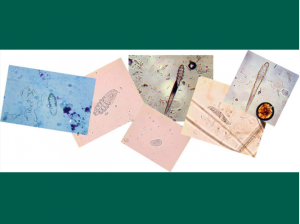571 – Skin is Your Dog’s Largest Organ, Keep it Healthy!
Skin is Your Dog’s Largest Organ, Keep it Healthy!
Dr. Marty Greer, DVM joins host Laura Reeves for a deep dive on skin problems in our dogs, how to avoid them, what causes them and how to treat them.
Pro Tip? An ounce of prevention is worth a pound of cure.
In previous episodes, Marty and Laura discuss allergies and external parasites, but today’s topic covers hot spots, seasonal alopecia, demodex and other skin disorders.
“The skin, believe it or not, is the largest organ of the body,” Greer noted. “So, it accounts for an important part of our dog’s health and it accounts for a huge number of visits. A lot of people have noticed skin problems in their dog. In fact, at some point, almost every dog will have something wrong with their skin during their lifetime. So, the better prepared you are to deal with it, the better off you are.
Hot Spots are a Hot Topic
“Our typical response to a hot spot, as a veterinarian, is to grab the clippers and shave it. And so that makes it a bit of a challenge for us to try and manage these because a hot spot needs to be treated similar to a wildfire out of the forest — you have to clear cut it. So, you have to clip out around it so that you’re an inch or two out around the hotspot into normal skin to effectively stop the spread of it. And so this is where the show dog people totally freak out because that’s that’s a year’s worth of hair coat. For some dogs that never grows back the same way.
“And this is where having a good veterinary relationship really comes into play. Your veterinarian is gonna be a lot more sympathetic to your needs and expectations if you have developed that relationship.
“It’s not that we’re unsympathetic to it, it’s just that we have to balance what your needs are with the dogs health and so that’s where this challenge comes in.
“It’s usually (caused by) a break in the skin of some kind, whether it’s an insect bite or they ran into the fence or you know, something that just dinged the skin. Allergies. Anything that causes a break in the normal integrity of the skin then allows bacteria to develop. The official name for it is an acute superficial bacterial pyoderma. It’s called a hot spot because it is hot, man. I mean, those things can spread … I’ve seen them double in size in 24 hours if you don’t get it addressed.
“You want to keep your dog healthy, their skin healthy. You want to keep them from matting. You want to be careful when you comb them or brush them that you’re not breaking the skin. That you reduce their exposure to biting insects because that can initiate it, and if they do have allergies, that you get a handle on those.
“Use your shampoos and conditioners carefully. Dilute your shampoo, rinse, rinse, rinse some more. Don’t leave any residue. You know, just be smart about how you’re taking care of your dog’s coat because if the coat is important to you, then treat it as if it’s important to you.”
Listen to the full episode to learn more on the topic of skin disorders.
398 – Getting Under the Skin: Demodex and other Mites
Getting Under the Skin: Demodex and other Mites
Dr. Marty Greer talks about Demodex, demodectic mange and other skin mites that can cause problems in dogs.

Slides of demodex mites from www.capcvet.org
“We can start with the history of Demodex, which used to be very serious. When a dog was diagnosed with Demodex back in the day, it was sometimes a death sentence,” Greer said.
“Over the years we’ve seen a huge change in the medications that we have as an option to treat Demodex with and it is no longer the scary, awful death sentence it once was. I still think we need to talk about Demodex as far as clinical signs and what that means for a breeding program and what it means for your dog’s health.
“We know that it is an autoimmune mediated disease. We believe it’s a B cell deficiency that the immune system doesn’t have actively functioning or well enough functioning B cells in some of these patients. Every single dog at birth is exposed to Demodex as soon as it’s exposed to his mother skin …. It is part of the normal flora, in very small numbers. Our immune system typically keeps it under control and if your immune system isn’t doing what it should be doing then that’s when the numbers are might increase to the point that you have lesions.
“There’s basically two categories of Demodex. There’s localized Demodex and generalized. So localized is exactly what you describe: the baby puppy with a little hair loss under their eye, maybe a couple of patches someplace on their leg or their trunk. Just a little patch of hair loss. It’s not uncomfortable, it doesn’t look angry. It’s just this little patch that you don’t see hair, frequently around the eyes but not exclusively there. A lot of people come in and they’re like ‘Oh yeah well he’s just been fighting with his brother it’s no big deal’ and you do a skin scraping and you find 30 Demodex. Well guess what? You have Demodex, you don’t just have a puppy fighting with his brother. So the first thing we will always want to do when we see a skin lesion on a young dog is to do a skin scraping.
“I think it’s important that you have a diagnosis. Especially if you have a breeding program and you need to know whether you have Demodex in your life. So I think we shouldn’t blow off doing skin scrapings. Demodex show up pretty readily … there’s a number of different kinds of mites that we can see in dogs and cats and Demodex is one of the easiest ones to find on the skin scraping.
“Generalized demodex can happen in puppies but it can also happen in adult dogs. If they are immunosuppressed. If they’ve got an immune system disorder. If they’ve been on too much Prednisone or other kinds of cortisone. Is thier nutrition hasn’t been good. If they’ve been on chemotherapy. If they’ve recently been in heat, they have cancer, if they have diabetes.
“Localized Demodex, it appears, has a genetic component. We see it really commonly in dogs like with Chinese shar-pei. But we see no indication, there’s no good research that shows generalized Demodex is genetic.”
Find more information on demodex here.


